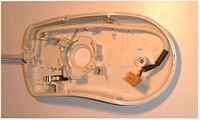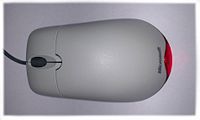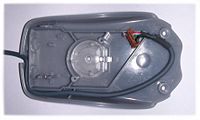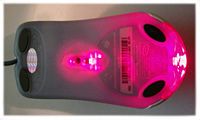Microsoft Computer Mouse
One of the simplest things to take apart is probably in your hand at the moment. The ball mouse offers some reward to the mechanically minded, although there are only a few electronic components. The modern optical mouse tracks motion without any moving parts, making use of a cheap imaging device instead. Click on the pictures below for a more detailed image.
My previous mouse was a standard Microsoft wheel mouse as you can see above. Mice generally have one or two screws and these are located under a sticker or pad. In this case there was one screw under the rear pad.
Removing the cover reveals a single board with a hole in the centre for the ball. There are three rollers around the hole. The white roller is simply there to push the ball against the other two rollers. The two black rollers measure the motion. One is rolled by forwards and backwards movement, the other by sideways movement. At the end of each roller is a disc with notches around the edge. The disc sits between an Infra-red transmitter and a pair of receivers. As the notches pass through the gap, light falls first one receiver and then on the other. The order depends on the direction of rotation, and the frequency determines the speed. This method means that there are no electrical contacts to wear out. Movement of less that a millimetre can be detected, and it can be done squillions of times!
The first two buttons rest on micro switches, which have a sprung contact inside. More expensive mice have longer lasting switches. They also use more advanced rubber for the ball, which doesn't wear so easily and doesn't pick up dirt.
My current mouse is a standard Microsoft optical wheel mouse, shown above. There are two screws under the rear pads, and two plastic catches under the front pads. These pads are the only parts which make contact with the mouse pad, and the mouse works equally well on a table cloth or even your knee.
Movement is detected using a CMOS imaging device built into the top of a processing chip. The surface under the mouse is illuminated from the rear using a red LED and a light guide. A plastic lens then focuses an image of the surface under the mouse onto the top of the imaging device. Movement of the surface is tracked by correlating surface features in successive frames. The image is enlarged so that very small features, such as those on a plain piece of paper, can be used. Reflective surfaces can cause problems however as the mouse tracks the reflected image of itself, which always appears in the same place - directly below it! In my mouse a second LED illuminates the clear red plastic at the back of the mouse - this is purely to look good and encourage buyers to spend a little more on the new technology.
The photos below show the underside of the mouse and the imaging device on the circuit board inside. The LED that illuminates the surface for the imaging device changes to half brightness when the mouse is picked up. This saves power and prevents the user accidentally looking into the bright LED, which is not dangerous, but it is uncomfortably bright. (Well you have to try it, don't you?)
The wheel in both models is on an axle supported at one end. The other end rests on a spring and micro switch, which detects the wheel being pressed. The fixed end of the axle has a notched disc to detect movement as with the rollers above. The axle also has a grooved section against which a piece of sprung steel is held. This provides the clicking action as the wheel is turned, and stops the wheel turning unintentionally.
One of my friends has a similar mouse, but the wheel rests in a cradle. The wheel has swollen slightly and can no longer be turned in the cradle. It is apparently a common problem with no easy cure, and so the later models do not use the cradle.
Links
- How a Mouse works - By http://www.howstuffworks.com
- Inside an Apple Pro Mouse - from Chipmunk International
- Cleaning a mechanical mouse - By http://www.helpwithpcs.com







